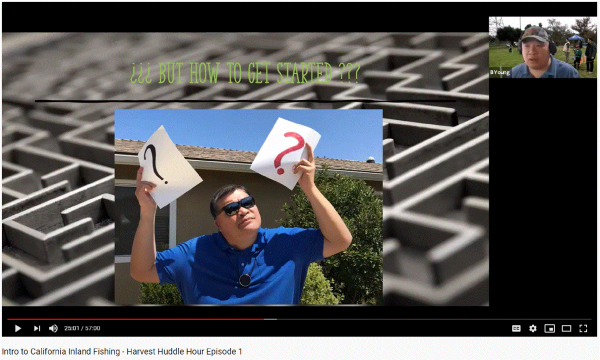California "Harvest Huddle" Online Programs Aimed at Encouraging Angling, Hunting and Foraging
 |
Novice hunters, anglers and even foragers – yes, foragers – have a new venue to learn the basics of these outdoor recreation experiences without the intimidation factor normally associated with picking up an outdoor sport like hunting or fishing. In August, the California Department of Fish and Wildlife began offering free virtual “Harvest Huddle Hours” as a pilot program to help those interested in pursuing hunting, fishing or foraging but don’t know where to begin.
The Harvest Huddle Hours are one small part of the department’s answer to the nationwide recruit, retain, reactivate, or R3, effort to reverse the decline in hunting, fishing and shooting sports. The U.S. Fish and Wildlife Service has participated in the development and now implementation of department’s R3 effort through Wildlife Restoration and Sport Fish Restoration Act grants.
“The department’s R3 effort is about turning barriers to participating in hunting, fishing and shooting sports activities into opportunities,” said Jen Benedet, the department’s R3 coordinator.
Benedet says that one of the most challenging barriers to increasing participation is a lack of programming for beginner adults that is also socially and generationally relevant, not gender-specific, and available to a wide geographic and socioeconomic audience.
Brian Young, the department’s Fishing in the City program, shares tips and tricks for beginner anglers. Photo courtesy of the California Department of Fish and Wildlife
“The Harvest Huddle Hours are virtual, open to everyone, and the content focuses on beginning adult participants who do not come from hunting and fishing families,” said Benedet. “The virtual platform allows anyone with access to an internet connection to show up, learn, and ask questions without the intimidation factor of feeling out of place or worrying about fitting in. It really is just about connecting people and humanizing the obstacles of starting something new, of learning a new skill set.”
And the new program seems to be working: each event hosted thus far has been at maximum capacity. Those lucky enough to get a spot learned how to get started fishing in California, basic hunting and fishing terminology and laws, and the basics of foraging for wild food in California.
“Service staff from the California-Great Basin Wildlife and Sport Fish Restoration program have been engaged for years in coordination meetings with the department to discuss barriers to outdoor recreation, and Wildlife Restoration grants have helped fund human dimensions studies, hunter education programs, mentored youth hunts, and how to prepare and cook harvested game, with some great wild game recipes, among other actions,” said Justin Cutler, Wildlife and Sport Fish Restoration grants management specialist for the Service in California.
Sport Fish Restoration grants provide funding to the state for aquatic education, maintaining access to trails for anglers, sport fish stocking and fish habitat restoration.
“Probably now more than ever, efforts to provide the public with opportunities to engage in the outdoors help us fulfill our missions and sustain conservation funding for the future benefit of the American people,” said Cutler. “I would encourage everyone to go make use of those opportunities in a way that works for them; fish, hike, hunt, paddle, attend a virtual Harvest Huddle Hour event, or just sit, watch, relax and enjoy the wild scenery of your local wildlife area. You inevitably will be directly or indirectly supporting R3 and our mission.”
To learn more about the department’s R3 effort, future Harvest Huddle Hours, or watch past events, visit the department's R3 web page and click on the California’s Wild Kitchen tab.
The mission of the California Department of Fish and Wildlife is to manage California's diverse fish, wildlife, and plant resources, and the habitats upon which they depend, for their ecological values and for their use and enjoyment by the public.
The mission of the U.S. Fish & Wildlife Serviceis working with others to conserve, protect and enhance fish, wildlife and plants and their habitats for the continuing benefit of the American people.
The Wildlife Restoration Act is a grant funding law administered by the U.S. Fish and Wildlife Service’s Wildlife and Sport Fish Restoration Program. Signed in 1937, it is one of the longest standing conservation laws in the U.S., and continues today as one of the first and most successful conservation funding programs in the country. As conservationists and lawmakers alike recognized a decline in wildlife during the 1930s, the act was passed to help conserve wildlife by establishing an excise tax on the manufacture of firearms and ammunition. The funds are placed in a trust and annually distributed to state wildlife agencies for the conservation of wildlife, and today are the bedrock of many state wildlife conservation efforts.
The Sport Fish Restoration Act is also grant funding law administered by the U.S. Fish and Wildlife Service’s Wildlife and Sport Fish Restoration Program. Signed in 1950, it establishes funding from excise tax on fishing equipment and electric motors, import duties on fishing tackle, yachts and leisure boats, and gasoline tax attributable to motorboats and small engines. These funds are placed in a trust and annually distributed to state wildlife agencies for the restoration and management of fish species for sport fishing and recreation, aquatic education, and funding of facilities that create or enhance public access for recreational boating.


 Advertising
Advertising